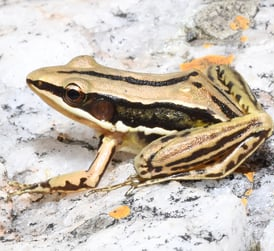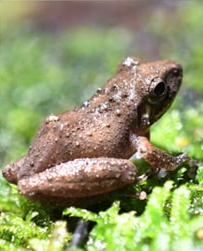TAG: GS 3: ECOLOGY AND ENVIRONMENT
THE CONTEXT: Recently, scientists have identified two frog species native to Sri Lanka thriving in the Eastern Ghats of India.
EXPLANATION:
- The existence of the Sri Lankan shrub frog (Pseudophilautus regius) and golden-backed frog (Hylarana gracilis) in India reveals an intriguing evolutionary history and points to a prehistoric land connection between the two areas.
- This discovery was made by a team of researchers from the Zoological Survey of India (ZSI) and the Andhra Pradesh Biodiversity Board.
- These amphibians are not new species, but their presence in the Eastern Ghats provides crucial insights into the region’s historical biogeography.
Historical Connection and Dispersal
- The researchers suggest that these frogs migrated, around 10,000 years ago during a period when a forested land connection linked the mainland to Sri Lanka.
- Changes in sea levels and monsoon patterns probably led to the isolation of these frog communities shaping their present day spread.
- Currently there is a distance of 700 kilometers separating their established habitats, in Sri Lanka and the Eastern Ghats region.
Habitat and Development
- The Sri Lankan golden-backed frog thrives in freshwater habitats, while the Sri Lankan shrub frog exhibits direct development.
- Unlike most amphibians that have a free-swimming tadpole stage, the shrub frog’s eggs hatch directly into miniature adults, bypassing the tadpole stage entirely.
- This unique reproductive strategy sets them apart from other amphibian species.
Significance of the Findings
- The golden-backed frog, first discovered in Sri Lanka in 1829, has now been genetically confirmed in India’s Eastern Ghats.
- Despite previous unconfirmed reports, DNA barcoding has provided definitive evidence of its presence.
- The Sri Lankan shrub frog was first described in 2005. Its discovery in the Eastern Ghats, 700 kilometers away, adds another layer of intrigue.
- Genetic analysis confirmed the species’ identity, though minor morphological differences such as colour variations were noted.
- The discovery of these frogs in the Eastern Ghats supports the hypothesis of historical sea level changes during the late Pleistocene period, nearly 2 million years ago.
- Land connections between India and Sri Lanka during this time would have facilitated the migration of amphibians and other species.
- This ancient connection is crucial for understanding the region’s biodiversity and evolutionary history.
Ecological Significance
- The Eastern Ghats are home to 28 amphibian species, compared to 253 in the Western Ghats and 455 across India.
- The discovery of these Sri Lankan frogs adds significant ecological value to the Eastern Ghats, which are considered important indicators of a pristine and healthy ecosystem.
- Amphibians, being sensitive to environmental changes, are key indicators of ecosystem health.
Endemic Species and Conservation
- Sri Lanka hosts 75 species of shrub frogs, while the Western Ghats of India have only three.
- All these species are endemic to their respective regions.
- The discovery of these frogs in the Eastern Ghats enriches the region’s biodiversity and underscores the importance of conservation efforts to protect these unique species and their habitats.
Sri Lankan golden-backed frog
- The Sri Lankan golden-backed frog (Hylarana gracilis) is an endemic species of frog in the Ranidae family.
- However, it was recently rediscovered after over 200 years in the Koundinya Wildlife Sanctuary in the Eastern Ghats of Andhra Pradesh, India.
- The frog has a slender body with a small head. Its appearance features a reddish-brown iris with golden specks and dark patches, light yellowish-grey flanks, and light brown limbs with greyish cross-bands.
- The throat and limbs are light grey.
- The Sri Lankan golden-backed frog was believed to be exclusive to Sri Lanka. It is found in various districts from sea level up to 1,250 meters.
- The new record from the Eastern Ghats, at an elevation of around 700 meters, represents an aerial separation of about 700 km across the Indian Ocean from its known range.

Sri Lankan golden-backed frog
Sri Lankan shrub frog
- The Sri Lankan shrub frog, also known as the Pseudophilautus tanu, is a species of frog endemic to southwestern Sri Lanka.
- It is a small frog, with adult males measuring 13.5-13.9 mm in snout-vent length.
- The Sri Lankan shrub frog has a pale brown dorsum with about eight dark-brown stripes of varying width.
- It has a distinct, vertically elongated tympanum and discs on its fingers and toes with circum-marginal grooves.
- This species is found in forest-edge habitats and open shrub areas in the lowland wet zone of Sri Lanka, at elevations of 24-45 m. Males have been observed sitting on leaves of shrubs 0.5-1 m above the ground.
- The Sri Lankan shrub frog is considered a common species within its limited habitat range. However, the unprotected forest edge areas it inhabits are under constant pressure from human activities.

Sri Lankan shrub frog
Spread the Word
